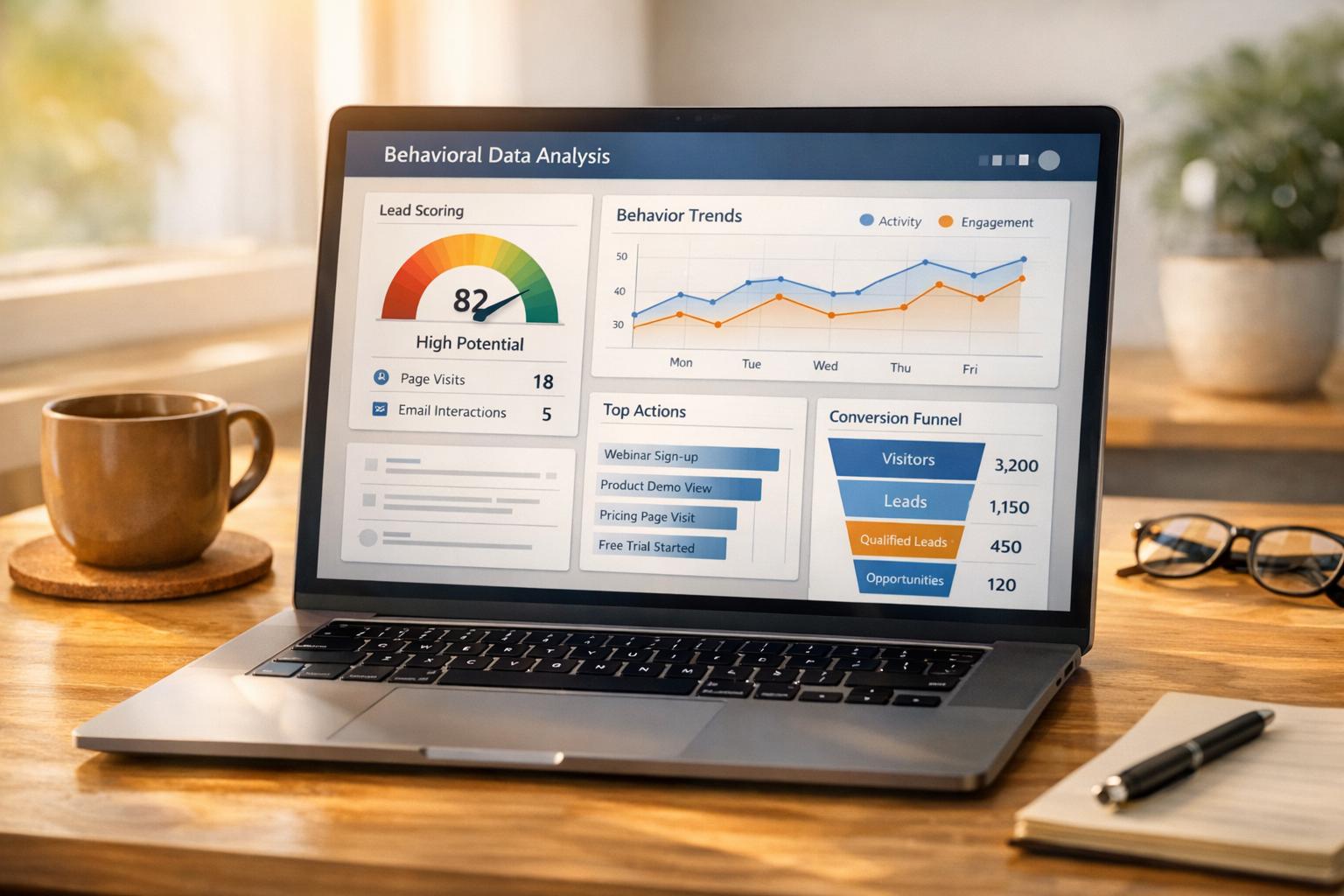
AI tools are transforming LinkedIn prospecting by analyzing user behavior to identify the best opportunities for engagement. Instead of relying on static data like job titles, these tools track real-time actions - like content interactions, profile updates, and job changes - to uncover buying intent. By combining this behavioral data with automation, sales teams can personalize outreach, leading to response rates of 6–10% (compared to 1–3% with traditional methods). Key benefits include:
- Real-time insights: AI flags actions like website visits, profile updates, or competitor content engagement to suggest ideal outreach moments.
- Personalized messaging: Messages are tailored to each prospect’s activity and communication style, improving relevance.
- Efficiency: AI evaluates hundreds of prospects in minutes, boosting reply rates to 45% and average pipelines to $100,000/month.
Platforms like SalesMind AI simplify this process, helping sales teams focus on leads most likely to convert. By leveraging behavioral signals, LinkedIn outreach becomes more precise and effective.
AI agent | Use LinkedIn profile data get your customer's personality profile
Data Points AI Collects from LinkedIn Profiles
AI tools create detailed prospect profiles by gathering two key types of information from LinkedIn: static data, which remains relatively constant, and dynamic behavioral signals, which reflect ongoing changes. Together, these insights help AI provide accurate and timely recommendations for outreach.
Static Data: Profile Details and Career History
Static data includes foundational details like job titles, company information, education, skills, and endorsements. These elements form the basis of a prospect's professional background. AI tools automatically pull this information to establish a clear picture of the prospect's role and expertise.
Career history offers deeper insights by examining past positions, tenure, and career progression. For instance, a prospect with a strong track record of advancing into leadership roles is likely to hold significant influence within their organization. Similarly, transitions between industries - such as moving from a legacy sector to technology - can signal openness to new opportunities or innovative solutions. Educational achievements and professional certifications highlight specialized expertise, while skills and endorsements showcase technical capabilities and the strength of their professional network.
Dynamic Behavioral Signals
Dynamic signals capture real-time updates that reflect a prospect's shifting priorities or potential buying intent. AI tools monitor these behaviors to identify prospects who are ready for immediate engagement.
For example, a sudden increase in LinkedIn connections might indicate a prospect is expanding their network, possibly due to a new role or involvement in emerging projects. Updates to their profile, such as revised job descriptions or newly listed skills, could suggest they are rethinking their career direction.
Significant events, like recent job changes or promotions, often signal ideal moments for outreach, as prospects may be more receptive during these transitions [2][4].
AI tools also track content interaction patterns - such as likes, comments, and shares - to identify topics and solutions that resonate most with prospects. Other indicators, like company growth announcements, funding news, work anniversaries, or certifications, reveal evolving priorities and open doors for engagement.
By combining these dynamic signals with static data, AI systems refine lead scoring and enable more precise, targeted messaging.
"By automating all conversations and personalizing them with direct insights extracted from my prospect profiles, it gives accurate and high-quality outputs that helped me get more prospect meetings and thus close more deals! It's definitely a game changer, thanks for this great tool!"
– Sébastien D., Freelance, Freelance Insider [1]
Platforms like SalesMind AI utilize both static and dynamic LinkedIn data to deliver advanced lead scoring and personalized outreach strategies. This comprehensive approach allows sales teams to connect with prospects in a way that's both timely and relevant.
How AI Tracks Prospect Activity and Engagement Patterns
AI keeps a constant eye on LinkedIn activity, building detailed profiles of prospects by analyzing their behavior. These insights reveal genuine interest and buying intent, helping sales teams pinpoint which prospects are most engaged and ready for meaningful conversations.
The process revolves around signal-based prospecting. Here, AI identifies specific behavioral cues that suggest a prospect's readiness to engage. These signals might include interactions with thought leadership content, views of a company’s page, or participation in industry discussions. AI tools can even pick up on subtle patterns, like repeated interest in certain topics or company updates, which often indicate a strong buying intent [3]. This data feeds directly into personalized outreach strategies, making communication more relevant and effective.
With these insights, AI revolutionizes LinkedIn outreach by crafting messages tailored to each prospect’s behavior. The result? Response rates that climb to 6–10% [3].
Content Preferences and Interaction Styles
Once AI identifies key behavioral signals, it dives deeper into how prospects interact with content. By tracking the types of posts prospects engage with - whether through likes, comments, or shares - AI gains a clear picture of their professional interests. This could include engagement with industry news, thought leadership pieces, product updates, or educational resources.
Even commenting habits provide valuable clues. For instance, prospects who leave thoughtful, detailed comments on industry posts might respond better to educational and in-depth outreach messages. On the other hand, reaction patterns - such as whether someone prefers public engagement like comments or more subtle interactions like likes - offer insights into their communication style. Additionally, monitoring what content they choose to share can highlight their current priorities and potential buying interests.
Frequency and Timing of Engagement
Beyond analyzing content, AI also examines when and how often prospects engage. Frequent LinkedIn activity or a sudden uptick in interactions with industry-related content can signal that a prospect is actively researching solutions. By evaluating timing - whether a prospect is most active during business hours, evenings, or weekends - sales teams can better schedule their outreach for maximum impact. AI also tracks consistency over time, distinguishing between prospects with sustained interest and those whose activity has waned, possibly signaling shifting priorities.
Frequency and timing data are often used to calculate intent scores, ranking prospects based on their likelihood to engage with sales efforts. For example, platforms like SalesMind AI use these patterns to deliver advanced lead scoring and automate follow-ups. By combining insights from content preferences and engagement timing, these tools help sales teams achieve an average reply rate of 45% and generate pipeline values averaging $100,000 per month [1]. This blend of behavioral analysis and static data ensures that outreach strategies are as effective as possible.
sbb-itb-817c6a5
Finding Buying Intent Through Behavioral Analysis
AI takes scattered LinkedIn activity and transforms it into actionable buying signals by analyzing multiple data points simultaneously. By diving deeper into prospect behaviors, this method pinpoints genuine buying intent. It removes the guesswork, empowering sales teams to focus on prospects backed by clear, behavioral evidence.
High-Impact Behavioral Signals
Certain LinkedIn activities are more telling when it comes to purchase intent. For example, job changes often signal a shift in priorities. New roles can mean fresh decision-making power or a reevaluation of solutions for their organization. AI tracks these transitions, flagging prospects who might now be in key positions to make purchasing decisions.
Another strong indicator is engagement with competitor content. When prospects interact with posts from rival companies - especially those highlighting product features, case studies, or pricing - it’s a clear sign they’re actively researching options. AI observes these interactions to create a fuller picture of their interests.
Leadership transitions and company announcements also carry weight. Events like funding rounds, expansion plans, or new leadership appointments often coincide with increased spending and a readiness to explore new solutions.
Lastly, engagement with educational content highlights prospects seeking answers to specific challenges. Whether it’s a whitepaper, webinar, or guide, this behavior suggests they’re on the hunt for tailored solutions.
Calculating Intent Scores
AI compiles these behavioral signals into intent scores, usually on a scale from 0 to 100, to help sales teams prioritize their outreach. Each signal is weighted based on its historical connection to successful conversions.
Recency plays a major role - recent actions (like engaging with your content yesterday) are scored higher than older activities. Frequency and consistency also matter. A prospect repeatedly interacting with industry-related content over several weeks shows stronger intent than someone engaging sporadically. Multiple interactions, such as viewing posts, reading articles, and following updates, further boost their score.
The combination of signals is another critical factor. For instance, a prospect who recently changed jobs, engaged with competitor content, and visited your company page in the same week would score significantly higher than someone showing only one of these behaviors.
AI-driven analysis delivers tangible benefits. Companies using signal-based prospecting have reported response rates of 6–10% - nearly triple the average for cold email campaigns[3]. These tools can analyze and qualify up to 500 prospects per campaign in just 20–40 minutes, making personalized outreach scalable and efficient[3].
SalesMind AI takes this one step further, helping users achieve an impressive 45% average reply rate and generate pipeline values averaging $100,000 per month[1]. By analyzing direct insights from prospect profiles, the platform ensures sales teams focus on leads with the highest potential to convert.
"Amazing tool that allowed me to save so much time on my LinkedIn outreach. But that's not all, by automating all conversations and personalizing them with direct insights extracted from my prospect profiles, it gives accurate and high-quality outputs that helped me get more prospect meetings and thus close more deals!"
– Sébastien D., Freelance, Freelance Insider[1]
This shift from mass automation to intelligent, signal-driven prospecting is changing the game for LinkedIn outreach. Instead of sending generic messages to large audiences, AI allows sales teams to connect with prospects at the perfect time, using messaging tailored to their specific behaviors and interests. These precise intent scores pave the way for creating highly personalized and effective outreach strategies.
Personalizing Outreach Using AI Insights
AI is changing the game for personalized outreach by turning behavioral insights into tailored communication strategies. After identifying high-intent signals, AI helps craft messages that feel authentic and align with each prospect's unique communication style, making connections more meaningful and effective.
Matching Personality Profiles and Communication Styles
AI dives deep into how prospects interact on LinkedIn, analyzing their behavior to uncover personality traits and communication preferences. By evaluating their activity, AI can generate MBTI-based personality profiles, offering insight into how they make decisions and prefer to communicate[5].
For example, AI studies the tone and language used in posts and comments to determine whether a prospect favors direct, results-oriented messaging or prefers a more relationship-focused approach. Someone who frequently shares data-driven content might respond better to messages highlighting metrics and ROI, while those engaging with thought leadership pieces may appreciate discussions about collaboration and industry trends. AI also tracks what type of content prospects engage with - those who interact with case studies are likely to respond to messages showcasing client success stories, whereas individuals engaging with educational materials might prefer outreach that offers resources or insights.
By aligning the tone and context of outreach messages with a prospect’s natural communication style, AI dramatically improves the likelihood of a positive response[3]. This approach ensures that every message feels tailored to how the recipient processes information, making interactions smoother and more engaging.
These insights also guide sales teams on the best timing and context for outreach.
Timing and Context for Messages
Timing can make or break an outreach effort. AI monitors a prospect’s activity patterns on LinkedIn, pinpointing when they are most active and likely to engage. It considers posting schedules, comment activity, and overall engagement trends to identify optimal windows for outreach.
AI also identifies contextual triggers that signal the right moment to connect. For instance, if a prospect interacts with competitor content, updates their job title, or participates in industry discussions, these activities provide natural entry points for a conversation. Instead of sending a generic cold message, sales teams can reference these specific actions to demonstrate relevance and timeliness.
Imagine a prospect recently liked a post about challenges in digital transformation. A message that acknowledges this interest and offers helpful insights feels far more genuine than a standard sales pitch. AI also determines the best follow-up timing by analyzing response patterns and engagement history[3][6], ensuring persistence without overstepping boundaries.
This signal-driven approach to prospecting can significantly boost response rates, achieving 6–10% - three times higher than generic email campaigns[3].
"SalesMind AI has elevated my LinkedIn experience, offering exceptional customer service to maximize the impact of their product. Their team not only assisted with implementation but also provided insights to fine-tune my campaigns, enhance my profile's appeal, and boost lead acquisition. The tangible results in terms of high-quality leads and business growth speak volumes."
– Bennett Newhook, Founder, Outport[1]
Conclusion: Using AI for Better LinkedIn Prospecting
AI has reshaped how sales teams tackle LinkedIn prospecting, turning behavioral data into actionable insights that drive results. With AI-powered messaging, response rates have jumped from a modest 1–3% to an impressive 6–10% [2]. This leap happens because AI can analyze prospect behavior on a large scale, delivering personalized, timely messages that genuinely connect with individuals. It's a game-changer for prospecting strategies.
Signal-based prospecting takes this a step further, transforming B2B sales approaches. AI tools can process and qualify up to 500 prospects per campaign in just 20–40 minutes [3]. This allows sales teams to focus their efforts on high-intent prospects. By identifying behavioral signals - like content engagement, profile updates, or interaction patterns - AI ensures sales professionals reach out at the perfect time with messages that matter.
A standout example of this evolution is SalesMind AI, which combines behavioral analysis with personalized LinkedIn outreach. With acceptance rates of 40% and reply rates of 45%, SalesMind AI helps generate an average pipeline value of $100,000 per month [1]. These numbers highlight the power of blending dynamic behavioral insights with tailored messaging, proving that AI tools can deliver impressive ROI while maintaining the professionalism LinkedIn networking requires.
AI integration in LinkedIn prospecting isn’t just about automation - it’s about intelligent automation. These tools not only drive engagement but also include safety protocols to safeguard user reputations [2].
For sales teams aiming to stay ahead, adopting AI-driven LinkedIn tools is no longer optional. This approach efficiently delivers high-quality leads without the need for additional hires. By leveraging behavioral analysis, personalization, and automation, sales teams can confidently face the challenges of tomorrow.
FAQs
How does AI distinguish between static profile data and dynamic engagement behavior on LinkedIn?
AI examines LinkedIn profiles by categorizing information into two main types: static data and dynamic behavioral signals. Static data includes details like job titles, company affiliations, and industries - providing a snapshot of someone's professional background. On the other hand, dynamic signals focus on activity patterns, such as recent posts, comments, and interactions, which offer insights into a prospect's current interests and engagement levels.
By monitoring these behaviors over time, AI tools can spot patterns, like when a prospect is showing increased interest in certain topics or content. This allows sales teams to fine-tune their outreach, making their approach more relevant and connecting with prospects at the most opportune moments.
What LinkedIn activities does AI analyze to identify strong buying intent?
AI leverages LinkedIn activity to identify potential buying intent, enabling sales teams to zero in on the most promising leads. Some key behaviors to watch for include repeated profile visits, interactions with posts (such as likes, comments, or shares), and replying to direct messages. Other actions, like downloading shared resources, attending LinkedIn-hosted events, or updating job titles and roles, can also hint at a readiness to make a purchase.
By examining these patterns, tools like SalesMind AI provide businesses with insights into prospect preferences, allowing for more personalized and timely outreach. This ensures that engagement efforts are both relevant and impactful.
How can sales teams use AI insights to create personalized LinkedIn outreach?
Sales teams can tap into AI-driven insights to create deeply personalized LinkedIn outreach. By analyzing a prospect's behavior, preferences, and engagement patterns, AI tools make it easier to understand what truly connects with each individual. This allows for messaging that feels relevant and genuine.
AI also streamlines time-consuming tasks like qualifying leads, scheduling follow-ups, and customizing messages. The result? Sales teams spend less time on repetitive work and more time building meaningful connections. This approach not only increases response rates but also fosters stronger relationships with potential clients, helping teams achieve their goals more effectively.


.avif)


